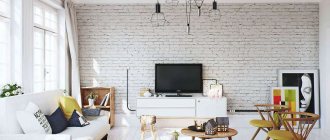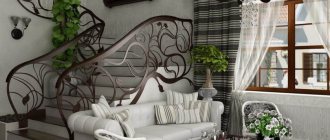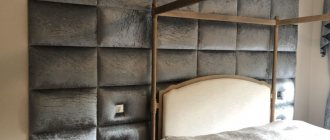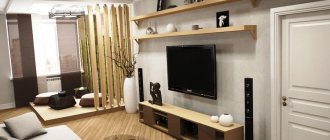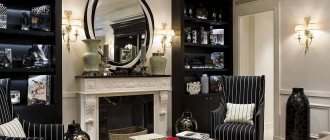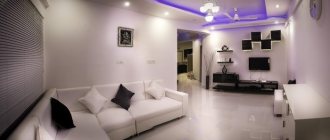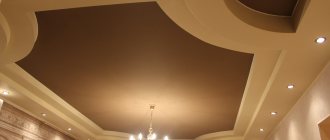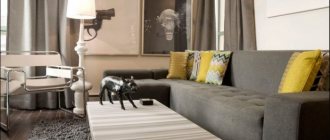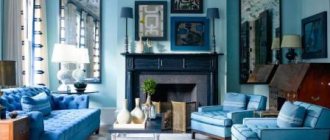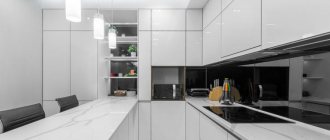Home » Decor » Wall decoration
DesignWall decorationInterior styles
Belyaeva Irina
61470 Views
A brick wall in the interior allows you to add zest to the design of your home in an affordable way. Highlighting a wall with brickwork allows you to create unusual, stylish and elegant interiors. Brick makes it possible to decorate a space in the most effective and original way. Everything will be discussed in more detail later in the article.
History and modernity
Brickwork in interior design has gained popularity thanks to lofts. Initially, the former factory premises were given to poor tenants who could not invest in a full renovation with plastering and painting.
This is how raw walls, which can be seen in old photos, came into fashion. Students and young families not only lived in such premises, but also held noisy parties with the participation of guests from various social classes.
This new direction in design became associated with bohemianism, industrialism and freedom, which appealed to city residents. Nowadays, brick wall decoration is again very popular, and can be used in combination with various styles.
You can also achieve an appearance that imitates brickwork using 3D wallpaper from picwalls.ru
Snow-white brickwork
Brick for interior decoration
Today, the material is becoming incredibly popular in the design of the interior of a home. Modern technologies also make it possible to create a skillful imitation of ceramic tiles to look like facing bricks.
With a competent approach and careful design, you can create a unique, original interior that will appeal to all family members.
Advantages and disadvantages
Any finish has its strengths and weaknesses. Let's get to know them before we start implementing our ideas.
Advantages: accessibility and simplicity
The undeniable advantages of using brick in the interior include:
- Financial inclusion.
- Safety.
- Naturalness.
- Good performance properties of the material (sound insulation, thermal insulation, moisture resistance).
- Ease of finishing. The design process using bricks allows you to cope with the task even without special skills and complex tools.
- You can use this approach in arranging almost any room.
- A brick wall can perform not only a decorative, but also a practical function - serve as a delimiter between rooms.
- Possibility to use hanging elements - shelves, lighting fixtures, TV, etc.
- Additional surface treatment is not necessary.
- Possibility of masking wall defects.
- Originality.
- Durability.
- Texture.
- Good compatibility with natural colors and natural materials.
- Decorative finishing.
Additional wall treatment is not necessary
Disadvantages: the main thing is to stop in time
There are quite a lot of advantages to this type of finishing. But what are the disadvantages?
The disadvantages of a brick wall in the interior of a house include:
- Untreated natural-colored brick needs high-quality lighting. As an alternative, you can use white brick or paint it.
- An uneven textured surface is difficult to clean.
- Too much brick in the interior design of a house can create the effect of an unkempt and cold room that lacks coziness.
An uneven surface is more difficult to maintain
The brick wall should be an original accent, and not occupy all the walls.
Decorate in a big way!
An uncovered brick wall can make a wonderful, vibrant backdrop for displaying an art collection or especially treasured family photos, as it is much more expressive than a plain white wall. With the right lighting and selection of decor and accessories, a living room with brick walls can look more attractive as furniture in neutral shades becomes noticeable. Decorating a room with brick walls is not easy, because if not planned correctly, eclecticism can quickly develop into chaos, an awkward mess.
A vibrant blue sofa, funky rug and plush armchairs bring life to the living room (from S&K Interiors).
Contemporary living room with copper rug and charcoal sofa (by James Maynard-Vantage Imagery).
Modern living room with an understated design (from A Design Lifestyle).
Decorating a brick wall in the living room with examples of modern painting (by Meghan Carter Design).
The centerpieces of this living room are a vintage light sign and a gorgeous storage shelf (from Meritage Homes).
Cheerful eclectic living room with stunning brick wall backdrop (by Mikel Irastorza).
Real masonry or imitation: what to choose?
In addition to using real brick, its imitation, wallpaper of suitable colors or tiles of appropriate stylization can be used.
Real brick wall
In this case, the masonry made from floor to ceiling is not subject to additional plastering or hiding under sheets of plasterboard. For a spacious room with high ceilings, one of the walls of the room can be left without additional covering.
Made from real brick
But processing must be present:
- The masonry is cleaned of dust and solution residues.
- They wash.
- Grinding.
- The joints are rubbed using putty or grout.
- Possible varnishing or painting.
Decorate the living room to your taste
Wallpaper with print
The simplest and most financially uncomplicated way of decoration is wallpaper with a corresponding pattern. The effect of masonry can be created not on the entire wall, but only on certain areas, for example, niches or wall fragments. Wallpapering can be combined with other decorative materials:
- decorative putty;
- natural wood;
- tiles.
Wallpaper with a pattern
Attention should be paid to the selection of colors and expressiveness of texture. The best effect is created by high-quality design material. Separately, it should be noted that the textured wallpaper can be painted. You can even give them the desired shade yourself.
High-quality wallpaper that imitates brick can be used in places that are inconvenient for decoration with other materials:
- narrow niches;
- on surfaces that have a bevel;
- on uneven surfaces, etc.
Excellent imitation
Advice A wide field for realizing ideas is provided by photo wallpapers that combine a “brick” background with another print, for example, graffiti.
Facing brick
Facing materials are currently presented very widely. It is lighter and thinner, compared to standard brick, takes up less free space and has a low weight . This circumstance allows the use of this facing material for finishing thin walls and in cases where it is important to economically manage free space.
The material can be:
- artificially aged;
- matte;
- treated with glaze.
Cladding materials are very popular
Brick-like tiles
Brick veneer has an even thinner thickness compared to facing bricks. Tiles can be of two main types:
- clinker;
- ceramic.
Before laying, the wall surface must be pre-leveled.
Interior design element
Independent production of cladding material
In addition to the listed options, imitation brick can be made independently. This requires molds, varnish and brick plaster. This option can be used if you need to create an unusual design using bricks of a non-standard format.
Brick wallpaper in the living room
Brick wallpaper is a trendy, textured, beautiful and extremely stylish imitation of natural brick. Brick wallpaper comes in different colors and shades, different textures and quality. They also differ in the material from which they are made and in price. The most common wallpapers are made of durable and pliable vinyl, breathable and dense non-woven fabric, and paper with a washable surface. And accordingly, the cost of a roll of such wallpaper will be different: the cheapest, but inferior in wear resistance, is paper, more expensive, high-quality and durable vinyl or non-woven.
Visual effects: how to influence the perception of space?
A wall made of traditional red brick is not the only possible option. The texture of the material and the laconic form of individual elements allows you to influence the perception of space. How to do it?
White wall
This option is used so often that it requires separate mention. Texture combined with white creates a good background for placing bright accessories.
White wall in the kitchen
The versatility of the shade allows it to be used in any room as the main design or to highlight individual zones. In white it is even possible to decorate all the walls in the room.
And at the same time the room will not look gloomy and basement. On the contrary, a light shade “adds” free space, making the room visually larger. Most often this technique is used when decorating bedrooms and kitchens.
Looks good in any room
Painting it white makes the design modern and dynamic.
What to combine brick with in the living room?
Brick provides great opportunities for arrangement - it looks great with the currently fashionable concrete , as well as with wood . Natural materials or their imitations harmonize perfectly with the “raw character” of brick .
Brick and wood in the living room are a very popular solution that allows you to create a cozy and warm atmosphere in the interior. A wall finished with brick will look great in combination with a floor finished with oak boards , for example, in a deep, rich shade. A combination of brick and wooden beams built into the walls or supporting the ceiling will also give a great effect.
Another interesting solution is concrete and brick in the living room. If you want the room to acquire a raw, even ascetic character , you can decorate one of the walls with brick and the rest with architectural concrete . This is an option for lovers of minimalism who value simplicity in interior design. Brick in a living room with a fireplace would also work. The fireplace surround can be lined with rich red brick.
We combine the incongruous
A brick wall is original, impressive and fashionable. But how can you choose the rest of the design as organically as possible?
Designers advise:
- Very often such a wall combines several shades. In this case, it is better to select furniture using the darkest and lightest colors as a basis.
- The rigor of the design can be enlivened by a bright carpet or eye-catching accents, such as colorful pillows on the sofa.
- Red brick color goes well with orange, yellow, and blue. This combination is especially effective in oriental ornaments.
Pros and cons of design solutions
Such a unique interior has a number of advantages.
- Uniqueness. This design will never look formulaic or banal. A real brick wall will always win in comparison with any wallpaper, even the most expensive, since nothing compares to brick modeling.
- Large color palette. Instead of the native shade of orange, you can repaint the wall in any shade. Most often it is light or brown.
- Compatible with decor. A brick wall will look good both without decorative elements, paintings, lamps, and with them.
- Pieces of furniture against a brick wall will look more impressive. An excellent design solution would be to install a fireplace. Even if it is electric, it will look good against the background of such a wall. Brick trim can highlight the elegance of the fireplace in a way that even the most expensive wallpaper cannot do.
- Feasibility of restoration. Wallpaper or other finishing will someday have to be changed, but a brick wall will last for many years and will not look worse if the brick crumbles over time.
- Reconstructing a brick wall is not difficult; to do this, you need to clean the area, cover it with a primer, and then paint it.
- Brick trim can be repainted when you get a little tired of the usual look, which cannot be done with wallpaper.
- The brick finish is durable and will withstand any moisture. No materials, be it wallpaper or plaster, like water, and can become unusable after a flood or carelessly spilled water. Water is not a problem for a brick wall.
In addition to a number of advantages, this finish has significant disadvantages:
- Price. Natural brick is much more expensive than simple wallpaper. There are many options for imitation brick on sale, which will cost less than natural ones, but they will not look like real materials.
- Difficult to install. A brick wall should look elegant, so it is better to trust a professional. It will be extremely difficult for a beginner to create such a design.
- Disassembling a brick wall is much more difficult than changing wallpaper or other finishes. Despite the fact that after the wallpaper you will have to prime the wall, this is not as difficult as dismantling a brick wall.
Brick in the living room interior: creating extraordinary effects
Decorating the living room with brickwork allows you to give the room a fashionable touch. The originality of this finish allows you to make the wall the main decorative element.
The larger the space in the living room, the more organic and impressive the brick wall will look. The combination with a light ceiling and wooden ceiling beams will give it style.
Organically fit into the interior
The spirit of antiquity is emphasized by the brick design of the space near the fireplace, the walls between the window openings and even the central wall. In addition to walls, brick can be used in partitions, fireplaces, etc.
Dark brick in the interior must be balanced with light shades. This can be done using furniture, textiles, and accessories.
Dark brick needs to be diluted with light furniture
Tip The presence of a fireplace in the living room can be played up by highlighting a part of the wall near it with appropriate design.
Brickwork in the living room
The use of this finishing option is incredibly popular. Most often, light shades of brick color are used. Brickwork can vary in area. For example, one entire wall of the living room is decorated with real brick or finished “like a brick” with wallpaper or decorative plaster.
Vertical masonry on the sides of the walls adds completeness to the interior; combinations of bricks of different shades look especially impressive. You can also lay out a partition or counter made of brick, provided that the living room area allows this.
Brick in the kitchen interior: a variety of options
The safety and durability of brick allows it to be used in the interior design of many rooms. In the kitchen it can be used in doses, allowing you to create an accent where it is needed.
Kitchen apron
This wall area is regularly exposed to steam, soot and grease. The apron occupies the space between work surfaces and wall cabinets.
Non-standard solutions
In order to facilitate the cleaning process, designers suggest adding a glass sheet to the exterior of the brickwork . This technique will preserve decorativeness and protect surfaces.
One of the walls
Decorating one of the walls with brick will look most impressive in an interior with a predominance of warm light shades:
- milky white;
- light gray;
- caramel;
- soft pink;
- cocoa shade.
Accentuating one of the walls
Part of the wall
Selecting a fragment of a wall looks no less impressive. Most often, this design is used for the dining area. In small rooms, this technique will allow you to delimit zones.
Niche
A natural or decorative niche lined with brick will help emphasize the historical orientation of the design, stylization of a rustic design, Provence style, etc. If a niche is formed near the stove, this will add retro touches to the decor.
Option for execution in the kitchen
Advice In addition to the listed options, a column in the room, a partition, a place near the bar counter, etc. can be decorated with brick.
Red brick in the living room is an ideal way to “insulate” the interior
Lovers of “warm” rooms can use red brick to create a space that fully meets their expectations. However, remember that the rusty color makes the interior seem smaller than it actually is, so in small rooms it is definitely better to choose only one brick wall - then the whiteness of the ceiling and other walls will be a counterweight.
This is also a good solution for long and narrow living rooms - a shorter brick wall will optically equalize the proportions. Larger living rooms allow for a little more frenzy, and the warm glow of a brick wall will further highlight the cozy character of the interior.
Combining brick with neutral colors is not only a way to create an interesting and cozy interior, but also a suitable backdrop for furniture in brighter colors. A sofa or chairs in bright colors will enliven the interior and bring a little freshness into it.
Colorful furniture will look good not only in modern or Scandinavian interiors, but also in rustic ones - just complement the entire composition with appropriate finishing elements, a stylish table and a simple pendant lamp/
Brick in the bedroom interior
Brick in the design of a bedroom can be used to emphasize the character of the finish. Most often, in a bedroom, one wall or an area near the head of the bed is bricked.
Tip To add the sophistication characteristic of Provence or to endow the room with romantic features, painting the brickwork with light paint can be used.
We bring ideas to life
How to put brick on the wall in the living room?
Lay the brick yourself or hire a specialist? You have many options if you want to use a brick wall . How to make a composition durable and aesthetic? Laying the facing material is not difficult, so you can roll up your sleeves and create an interesting composition with your own hands, in which the bricks in the living room will play the first role .
How to impress family and guests? If you decide to use natural old brick, the first thing you need to do is prepare the base - remove the remnants of old wallpaper and paint, and then prime the surface.
Styles: choosing a design option
Brick is distinguished by its versatility as a finishing material. Its use is most justified when decorating an apartment in the following styles: loft, country, Provence, etc. Such design of vertical surfaces is impressive and relevant.
Loft
Housing organized on the territory of former production premises, workshops or factories is characterized by a large area and high ceilings. These advantages allow you to implement design techniques that are not always acceptable in small apartments. These include wooden ceiling beams, columns, and brick decoration.
Loft style
The loft allows you to leave open electrical cables, heating pipes and other elements that highlight the technical engineering equipment of the house. Bricks are also a suitable backdrop for placing video and audio equipment.
Country
A style that uses natural materials and naturalness in design goes well with the design of country houses. The comfort of simple interiors with fireplaces and natural materials is emphasized by a brick tub combined with wood. This design is associated with relaxation and outdoor recreation.
Country style
Gothic
This trend dates back to the Middle Ages. The Gothic style uses brick in decoration in combination with forged parts of furniture and accessories.
Minimalism
Red brick, brown, white and gray colors should go well with the overall design - ceiling, floor and furniture.
When nothing is too much
Grunge
Mixing several styles and design trends allows you to introduce the most whimsical elements into the interior. The stylishness achieved in this way can become a distinctive feature of your home, and emphasize its dissimilarity with the homes of friends and acquaintances.
Ecostyles
Unity with nature, the use of wood, stone and natural fabrics in the design allows you to create a very cozy home. Brick, with its emphasized environmental friendliness, can become one of the components of such an interior.
We create cozy housing
High tech
Far from the word “ecologically friendly,” urban high-tech can also be combined with brickwork. Most often, imitation tiles are used for it.
Classic English interior
The emphasized rigor of design and correctness of English classics can be combined with brick elements. The touch of aristocracy and style inherent in medieval castles of the English nobility can be accentuated by the use of brick decoration.
Refresh with a light sofa
Brick in the living room - is it suitable for every home?
Brick on the wall in the living room is a great idea that has been very popular for several years. This home decor trend will look good in almost every home, whether you have a large space or are the owners of a small room and just want to use brick in the living room.
Design ideas using this material show that the key to success is choosing the right brick and its color, and in some cases also placing it only on a small part of the wall. If you want to choose brick for a small living room, you should also remember about appropriate lighting for the living room, which will highlight the facing material and give the room a cozy atmosphere.
Brick in the living room and dining room is also good - a bare fragment of the wall could, for example, be on the wall connecting both zones. Thus, it will separate the seating area from the place where you prepare food. This versatile cladding material can be used almost anywhere. Want to know where brick would work best for your living room? The best interior ideas with brick are presented later in the article.
How much does decorative brick cost for a living room wall?
This is a question that many people ask themselves when they want to add a brick wall to their living room. The cost of the service will depend on the type of facing material and the scope of work. In the case of imitation gypsum brick, the cost starts from 490 rubles / m2. Hand-painted brick on the living room wall is definitely more expensive . The price ranges from 1,200 rubles / m2.
In turn, white gypsum brick costs from 450 rubles / m2. If you want to choose a solution that entails the least cost, you can use brick-look wallpaper .
Is the brick in the living room real or imitation?
In older houses and apartments, it is possible to display the original bricks used in the construction of the house. Old brick in the living room may appear, for example, when renovating an apartment or remodeling an attic. If you want to use it for decorative purposes, you must thoroughly clean the brick and then impregnate it with a special preparation.
Of course, using old brick is just one possibility. More popular is the use of decorative brick in the living room - a facing material in the form of tiles that are placed on the wall like ceramic tiles. Many people decide to use tiles cut from the face of old brick . The material can be obtained, for example, from demolishing houses.
Brick-look tiles are also popular and are available in the market in a variety of colors and types. They are definitely lighter than wall tiles, so the possibilities for their use are wider.
Using bricks: tips and tricks
How to preserve masonry and avoid tarnishing and defects?
Real brick is beautiful in itself, has a pronounced texture and a characteristic shade. How to preserve it without losing quality characteristics and color? For this, interior designers advise using special protective compounds.
If there is a lack of light, which occurs, for example, in a hallway, the wall can be varnished with a slight glossy effect. This will ensure color preservation.
In sunny rooms, you can varnish with a matte effect. Such protection will be completely invisible, but at the same time quite reliable.
In an industrial interior
Is old brick good or bad?
The old brick wall looks historic, attractive in its rugged beauty. But for the interior it must first be put in order. For this purpose, brushing is used. You may need to wipe the stained areas with a mixture of vinegar and water.
Advice: Before using aggressive cleaning agents, check the condition of the brick. A crumbling surface cannot be treated this way.
With the effect of old brick
High humidity: how to overcome it?
In rooms where there is often high humidity, such as a bathroom, protecting the brickwork comes first. To do this, the crumbled seams are deepened a couple of centimeters, and then restored with a new solution. The next step is sealing to protect against mold.
Protecting brickwork
Impact on visual impression
Brickwork is a spectacular and expressive element of the living room. In addition, depending on the color scheme and the nature of the placement, this option can also be used to visually change the proportions of the living room.
Brickwork in the interior is most often designed as follows.
- White decorative brick in the living room interior is the most popular and universal solution . This color is neutral, visually brings the walls closer, but at the same time noticeably increases the illumination, so that in the end the room looks more spacious than it actually is.
The photo shows the interior of a living room with a white brick wall.
The only white brick wall in the living room interior is combined with light or dark plastered walls, painted wood panels, and even a smooth concrete surface. At the same time, it visually expands the space. In a narrow white room, it is better to make a short wall to correct the proportions of the living room. In a room with 2 or 3 white brick walls, the effect of expansion disappears, but the impression of greater space remains.
The photo shows a living room with white brick.
A white brick wall in the living room interior can be combined with any accessories, any color of furniture and any other decoration of the room. White serves as both a neutral background and a divider. Fragments of white brickwork are an ideal way to zone a living room-studio. The photo shows what a white brick wall goes harmoniously with.
- Gray color is no less universal and even more convenient in that it includes a large number of shades . It can act as a neutral background like white, or it can include several shades to design each element and create an original color structure.
To decorate living rooms with windows to the south, it is preferable to choose cold gray tones; for rooms with windows to the north, warm ones. Gray goes well with both white and black. However, it is the last combination that is more expressive.
The photo shows the interior of a living room with a white and gray brick wall.
- The vintage effect is achieved using dark brick . In large living rooms, dark brown and red shades are used, and black can be used to decorate any room. Here it is only important to maintain the correct combination of light and dark areas. A fragment of black brick masonry is an extremely effective background for a mirror, painting, or fireplace. This area allows you to change the proportions of the room.
The photo shows a brick wall in the living room with a TV.
- Graffiti. Brick, facing tiles (not ceramic), clinker, plastered brick can serve as a backdrop for self-expression. The stone can easily withstand repeated painting. Graffiti is one of the most fashionable design elements, giving the interior a kind of hooligan touch.
The photo shows a brick wall in the interior of city apartments.
Work on mistakes
Using such a simple and yet quite complex material, it is necessary to take into account some features of brick:
- Once the wall is painted, it is extremely difficult to remove the paint if necessary. This is due to the porosity of the structure and good absorption.
- It is not advisable to completely highlight a long wall with brick. In this case, it must be “broken” with pieces of furniture, mirrors or decor. This way it will be better perceived visually.
- Mirrors reflecting a brick wall will help unite the space of the room into a single ensemble.
- The paintings look very beautiful on brick walls. The more there are, the more attention is drawn to the wall itself.
- Hanging open shelves hung on such a wall add coziness. Their color and material are selected taking into account the style of the room.
Bright accent
VIDEO: How can you use brick on a wall?
Brick wall
Ideas for your interior
Care and use
The design of a kitchen or living room with brick attracts with its authenticity. In addition, such finishing, even if it is panels or tiles, is very durable and practical. However, a brick wall also requires maintenance.
The recommendations are simple:
- If the masonry is not covered with a protective layer, the wall should be periodically washed with warm soapy water and a stiff brush. Serious stains can be removed with water and vinegar. Most often this is done when trying to maintain an aged appearance;
- plastered or whitewashed brick tolerates only dry cleaning - with a soft cloth or vacuum cleaner;
- the painted brick wall in the hall is cleaned with a damp sponge;
- in styles where “refined” masonry is preferred, the brick is varnished. For rooms with not very good lighting, it is recommended to use a semi-gloss varnish. For bright and spacious living rooms - matte. The varnished surface is wiped with a damp sponge and washed with warm soapy water. Abrasive products are not allowed to be used;
- For plastic panels or MDF models, dry cleaning is more suitable. For heavy stains, you can use water with washing powder and a sponge, but after this the panel should be wiped dry.
Brick in the interior of an ordinary apartment adds originality to the living room, kitchen, and bedroom. It's worth spending the extra half hour cleaning.
Photos in various interior styles
This finishing option, which has a variety of patterns, colors and textures, provides the opportunity to design any interior styles, such as eco-style, loft, hi-tech, Provence, modern style and others.
The photo shows decorative brickwork in the interior of a kitchen-living room in a loft style.
Using cladding that imitates sandstone or raw granite, you can easily decorate rooms in a chalet or country style; light-colored marble or gypsum stone are an excellent solution for reproducing a classic atmosphere. Dark decorative stone imitation of expensive species is suitable for decorating columns in the Rococo or Baroque style, and products with imitation of aged stone material will harmoniously complement the retro style.
General rules of application
The main principle of using brick in the interior is very prosaic. Experts note that this material brings maximum beauty and comfort to the interior only in cases where it is used in reasonable quantities. Ignoring this recommendation makes the room too cold, depriving it of the desired comfort.
Basic techniques for using brick finishing:
- highlighting an accent wall, optimal for transforming any room in the apartment;
- finishing of various architectural elements (most often these are arches, columns, partitions and decorative recesses);
- highlighting the fireplace area, most relevant for the living room.
It is also worth adding that walls decorated with decorative bricks can become an excellent backdrop for paintings and photos. In addition, the material in question goes well with gypsum tiles, which often act as an imitation of natural stone.
To prevent the atmosphere in the room from seeming too strict, you should pay attention to the color of the material and the specifics of the decoration. An example is decorating walls with white brick, effectively complemented by bright and cheerful tones.
Another significant point is the quality of the material used: it is desirable that the brickwork be natural. If the home owner relies on the use of imitation, then the latter should be as good as possible. This step allows you to avoid bad taste, which hopelessly spoils the interior decoration of the room.
Solid brick finishing
A complete material that is usually made from high quality clay. Such products allow you to imitate different natural textures: from river to torn stone.
Facing brick is reliable and durable, has excellent resistance to aggressive weather conditions and various mechanical stress, retains heat in bad weather and cool on hot days.
In addition, experts note its excellent aesthetic qualities and high resistance to abrasion, which allows it to be used for finishing living rooms, offices, bedrooms, dining rooms, corridors and even bathrooms.
Fireplaces decorated with such bricks will tell about the high status and amazing taste of the owner. A large abundance of shades and textures allows you to realize the most non-standard and daring ideas.
Kitchen ideas
Try decorating your kitchen with white brick - and you will see how much the entire interior will be transformed
The main secret is that finishing the walls with white brick will certainly attract attention, regardless of whether the whole wall is decorated with brick or only partially, i.e. any separate zone
Quite often, a white brick wall in the kitchen is created for visual zoning into the working and dining areas.
Let's look at a few design ideas for a white brick kitchen interior.
If you decide to use wallpaper for a white brick wall, try to choose durable coatings with wear-resistant properties (for example, based on non-woven or vinyl), which are easy to clean and can easily withstand moisture.
Advice. Vinyl and non-woven wallpaper are best used where negative impacts are minimal, and not in the cooking area: you can decorate a wall with a door or window or create an accent near the dining table.
Using small tiles with a brick design will not help create a background throughout the room - it is the small elements that are the problem. It is advisable to use such finishing only to create individual accents.
The photo below shows one example of a white kitchen with a brick wall: the accent was part of the wall in the dining area
Please note: brick is in perfect harmony with different materials and palettes:. Kitchen with white brick wall, photo
Kitchen with white brick wall, photo
The photo below is another ready-made example of a kitchen with a white brick wall: white decorative brick tiles are used here to create a backsplash. As you can see, nothing prevents the fastening of wall-mounted furniture, auxiliary elements and equipment to the brick surface.
In the interior of the kitchen, white brick can be used to decorate furniture elements: you can veneer the façade of the furniture, create a stylish decor for the bar counter, or decorate the island. If the material is chosen correctly, a kitchen with white brick will become both practical and stylish.
Decorative lighting for a brick wall
Beautiful sconces and lamps are an invariable attribute of a stylish and modern room. To favorably emphasize such a catchy design element as natural masonry, start from the style of the interior when choosing lighting fixtures
Various lamps in the decor of a brick wall
- minimalism and Scandinavian style - laconic lamps of geometric shapes made of metal, as well as simple garlands;
Metal lamps in the decor of a brick wall in a minimalist style
- loft and modern style - complex metal structures, imitation lanterns;
Unusual lamps on a brick wall in a loft style
- classic and Provence - gilded sconces with pendants, candelabra;
Sconce-candelabras in the decor of a brick wall in a classic interior
- boho - various multi-level garlands, colored glass models, gold and silver wall lamps;
Garlands for decorating a brick wall in a boho interior
- high-tech - hidden lighting around the perimeter or immediately under the ceiling;
Lighting under the ceiling near a brick wall in a high-tech interior
- Art Deco - gilded and silver-plated models of complex shapes with glass elements.
Sconce with pendants on a brick wall in an Art Deco style interior
How to choose wallpaper for a brick wall?
The brick wall is the highlight of the room. It does not require additional decor, and in itself is an attractive element of the interior. The wallpaper that covers the remaining walls should set off the brickwork or echo it in unison. This means that they should be a contrasting color or the same color as the brick, but a shade lighter.
The color of the brick can be very different, the main thing is that it is in harmony with the overall decor of the interior.
Loft is an original style that does not tolerate excesses. Everything here is simple and clear. It is characterized by conciseness, free space and a single color scheme. Following the canons of the urban direction, use one color and several shades of it. A monochrome interior has the right to life, but with one caveat: if all the walls are the same color, then the brickwork should be decorated with photographs or paintings.
Brick, as well as its imitation, in the design of a room looks original, fashionable and beautiful.
A living room that combines white and black, or gray and black, looks beautiful. In this case, the contrast of the achromatic scale is reminiscent of the Yin-Yang concept. If you are passionate about creating a loft, then choose wallpaper in pastel and cool colors to get a light and muted interior.
A fireplace against the backdrop of a brick wall immediately transports you to the times of towers and castles.
Important! Street style combines effectively with wallpaper depicting graffiti. This option appeals to young people and creative people.
Grunge fans who are ready to combine several styles into a single whole are allowed a lot. They can deviate from established rules and boldly experiment with colors.
If the loft is characterized by a monochromatic covering, then grunge is prone to wallpaper with ornaments.
Important! To ensure that the brickwork fits harmoniously into the room, choose wallpaper with a fine pattern.
The location of the wall on which the brick will be placed also matters. It can be central or lateral. In the first case, choose wallpaper that is a lighter tone, in the second - brighter. Most often, luscious coatings are chosen for functional walls on which a TV or fireplace will be placed. When the TV equipment is located on brickwork, the wallpaper should be monotonous or with a small pattern.
A plasma TV screen on a stylish wall gives the room the warmth of a home.
The hall in a residential building is a place where the whole family gathers. It offers a relaxing environment characterized by vibrant colours. Choose wallpaper based on your own taste and design.
How to make a brick wall: manufacturing and painting technology
Before you start work, you should decide on the design. Finishing in the form of brickwork can be done in various ways:
Before starting work on installing decorative bricks, it is worth marking the wall according to the intended design
- fragment;
- as an accent;
- the whole wall;
- in the form of a decorative element.
If partial finishing is required, a small area of the surface is covered with brick. This method allows you to emphasize the solidity of the walls of a living space.
Interiors using brickwork look especially interesting and unusual
Helpful advice! It is advisable to use fragment design to create an interior in a Scandinavian style.
Wall with imitation brickwork as an accent in the living room interior
Using an accent, you can highlight a certain part of the wall that requires special attention. This method is most often used to advantageously play up the central objects of the interior:
- area around the fireplace;
- the wall located behind the head of the bed;
- area where a TV is installed, etc.
To highlight a separate part of the room, which has the main semantic load, an entire wall is decorated. In the living room this method is used to highlight the sofa, in the kitchen - the dining area, in the bedroom - the bed.
Using bricks you can make individual architectural details. Such an element can be a section of a wall located separately, an arch or a bar counter.
How to create an imitation brick wall with your own hands
Having determined the key points of the design, you can begin to create a finishing material to imitate masonry. To make bricks, you will need a special mold for pouring and a coloring composition. Experts advise using transparent varnish and brick plaster for this. A polyurethane mold for pouring can be purchased at a store or made independently from plastic. The main thing is that it has the appropriate size and shape. And the size of the bricks can be different, as long as they remain rectangular.
First, in accordance with the instructions, you need to prepare a gypsum mixture. It is then placed in a pouring mold and left to dry completely. After making sure that the bricks have frozen, you can take them out. The finished elements are fixed to the wall using glue intended for laying tile products. To get a more realistic effect, you can partially break the edges of some bricks. The thickness and size of the elements is selected at personal discretion.
To create facing bricks, a special gypsum mixture and molds are used
How to paint a brick wall in the interior
You should not start painting immediately after the masonry is completed. The finish must dry to allow moisture levels to reach natural levels. This process may take several months, but during this time all active alkalis are completely neutralized.
Technology for painting a brick wall:
- The surface is cleaned of defects and solution residues using a grinding machine.
- A layer of primer with antiseptic additives is applied.
- The wall is painted lengthwise so that each subsequent strip overlaps the previous one by 2-3 cm.
- After the first layer has dried, apply the second in a vertical direction.
You can highlight a separate part of the room, which has the main semantic load, by decorating the entire surface with brick
Anyone can make and paint a brick wall, the main thing is to choose suitable materials for this and adhere to the requirements of the technology. If the apartment does not allow you to use real brick as decoration, you can always make an imitation of it. To do this, just paint the wall in the desired color and apply decorative seams over it, or use a special roller and putty to get a more voluminous result.
What brick to use for wall decoration?
The design of a room with a brick wall is worth considering. First, choose a location and type of decoration. Will the brick fill the entire wall or appear in patches? Remember that the material is quite bulky and draws attention to itself. Having decided on the location, move on to the essentials - the material. Brick is used for wall cladding:
- red;
- white;
- facing;
- decorative.
Important! Using natural brick to decorate a room has a lot of disadvantages: labor-intensive work, narrowing of space, load on the floor.
Red brick is the most common. It is chosen in various shades, ranging from light orange to brown-brown. It conveys the idea of a loft and the spirit of the times when people inhabited industrial premises. Despite this, white brick continues to be an element of minimalism, country, Provence and Scandinavian style.
The beauty of brick walls brings warmth to a small living space and makes it feel invitingly homey.
Facing colored brick is thinner than ordinary building brick, but more than decorative. It requires less space than conventional construction material, is intended for finishing surfaces, and is suitable for creating partitions.
In addition to masonry, you will need a primer and a coating of clear acrylic varnish.
When an apartment needs redevelopment, choose facing bricks. It can be glazed, that is, with a smooth front surface, or embossed. For cladding load-bearing walls, they use bricks with a double-sided coating (spoon and poke), for the construction of a partition - with a four-sided one, in order to get beautiful masonry in two rooms. This way you can save on consumables.
Using facing bricks on artificially created walls with a small thickness, you do not have to spend money on decorative finishing materials.
Decorative brick comes in a variety of textures, shapes, sizes and colors. It does not take up much space, is easy to process, and can be laid on durable surfaces without complex equipment.
This type of brick is appropriate on open walls and is used for aesthetic purposes.
When choosing between materials, focus on the end result and budget. Inexpensive options would be tiles and brick-like wallpaper, but they also have their drawbacks.
Brick wall in the interior of the room and the choice of material for its creation
The design of an apartment in the interior of which there is a brick wall, despite its apparent roughness, is successfully used by decorators. Finishing in the form of natural or facing bricks allows you to create contrast in the room, give it an exclusive and natural look, and also attract attention. In addition, a wall made of decorative brick can be used as a basis for creating many modern styles.
Brickwork is often used in interior design in a classic style.
To create the effect of a brick wall, various materials can be used:
- facing brick;
- glass brick;
- imitation using wallpaper;
- plastic panels;
- clinker tiles;
- plaster imitation, etc.
How to create a bare brick wall in the interior: photos of premises and recommendations
The most natural way to get a brick wall is to build one or expose an existing surface. This option is available to residents of private brick houses. It is enough just to leave one of the walls unfinished to get a unique design. If the house is new, then the alteration will be minimal. In this case, the walls can be left in their original form, while removing minor dirt that remained after construction. If the building is old, careful processing will be required.
The combination of exposed brickwork with a smooth wall surface allows you to get an interesting decorative effect
You will definitely need to remove all layers:
- whitewash;
- primer;
- plaster;
- finishing material.
You also need to carefully remove traces of construction dust, cement and eliminate all stains. For this, special solutions are used. After this, the surface of the wall is sanded and all seams are rubbed. A picture in a frame made of a wide baguette, or a photo, is suitable as a decor for this background.
Helpful advice! Cleaned brickwork in the interior will look attractive if you open it with colorless varnish. To avoid the “wet stone” effect, it is advisable to use matte compounds.
It is recommended to cover exposed brickwork with a layer of protective varnish
Imitation of a brick wall: photos of interiors using wallpaper
Unlike private houses, apartments do not have suitable conditions for the construction of brick walls. There are restrictions on the weight acting on the floors, so an additional partition can cause overload, cracks and even collapse. It will also not be possible to expose the wall, since slabs and other monolithic materials are most often used for the construction of multi-story buildings.
Residents of city apartments can create an imitation of a brick wall using wallpaper. This method does not require significant modifications. The material conveys the features of the texture quite realistically. The wallpaper imitates all the abrasions, cracks and other relief features of natural brick. In this case, the buyer can choose the appropriate color and design in the store or paint the wallpaper themselves.
You can create an imitation of a brick wall using wallpaper
To create a brick wall, you can use plastic panels. This finishing material is decorated with a printed image of masonry that looks like the real thing. Unlike wallpaper, plastic panels are more practical, but you will have to tinker with their installation. In addition, this material cannot be called completely environmentally friendly.
Lightweight brickwork: photos of rooms with facing bricks
In modern interiors, facing bricks are often used to create beautiful walls. This material is called thin-walled. Cladding bricks are much thinner than those used for construction, making them ideal for residential use. As a result, it becomes possible to save useful centimeters of space, since the finishing takes up a minimum volume. Another advantage of facing bricks is its light weight. This material allows you to decorate thin walls without the risk of destruction.
The red brick wall harmonizes perfectly with the interior, decorated in white.
There is a wide range of facing bricks on the market, so the consumer can choose the appropriate option. Buyers have access to any colors, textures and shapes, as well as materials with a matte or glossy surface. In addition, in stores you can find bricks that look like new or aged.
To create a decorative brick wall, glue is used, with which the elements are fixed to the surface. For these purposes, it is advisable to use compositions intended for laying natural or artificial stone.
To create an imitation of brickwork from facing bricks, specially designed adhesives should be used
Helpful advice! After the wall is completed, all seams between the bricks should be treated with tile grout.
Scope of application of facing bricks:
- construction of columns and partitions;
- performing full or partial finishing of walls for brickwork;
- design of the area by the fireplace;
- creation of niches and shelving.
This material is strong, durable and environmentally friendly, available in a wide range of colors. Therefore, it can be successfully used both to create a white brick wall in the kitchen and to finish surfaces in the living room, bedroom, hallway and corridor. The material has the correct shape, which greatly facilitates its installation.
The texture of a brick wall brings a feeling of comfort to the interior
Using tiles and glass bricks in the interior
Brick tiles will be an excellent finishing material. Its second name is “brick veneer”. Unlike the previous version, this tile is lighter and thinner. Most often you can see in the photo white brick walls in the kitchen or bathroom, decorated with this material, although other colors are also available.
Tiles can be clinker and ceramic. Installation of the finish is carried out in the same way as laying regular tiles. To do this, the surface is carefully prepared and leveled. The tiles are fixed to the wall with a special adhesive composition. To avoid skew, experts recommend using plastic crosses.
Tile imitating brick is an excellent solution for kitchen decoration
Glass brick is used in modern interiors. The material is presented in the form of matte or transparent blocks of several colors:
- red;
- gray;
- green;
- yellow.
Decorative brick can be used to decorate any premises
The presence of decorative brick in the interior will fill the room with light and visually expand its space. The material is suitable for decorating walls in the hallway, living room or corridor. Glass brick can also be used for zoning a room. In apartments with limited space, it can act not only as a decorative finish, but also serve as a screen.
Decorative brick for interior decoration and its properties
Varieties and properties. Possibility of using decorative bricks in the interior of apartments and houses.
Installation of decorative bricks
Installation must be carried out by specialists, just like laying tiles; this activity requires practice. You can always try to do the repairs yourself - just like wallpapering, laying decorative bricks with due diligence can become a reality even for a beginner. For installation, you need to purchase all the necessary materials, dilute the cement mortar, apply it to the wall with a spatula and begin installation. If you plan not to make gaps between the tiles, you should take into account that the rectangles of the tiles are not perfectly even and if you do not take care of this, the level may shift and the entire row will “float”.
See alsoDecorative lighting can become the highlight of the interior
Living room design and important conditions for comfortable communication
The decor of a modern living room does not imply strict minimalism
There must be objects in the room that the visitor will pay attention to at the stage of familiarization and getting used to the new environment.
A guest who has just arrived for the first time must be given time to psychologically adapt to the new environment, calm down after traveling, climbing stairs, etc.
To do this, you need to leave him in the living room for a few minutes, preparing tea, coffee, and treats during this time. It is good if the visitor spends this time getting acquainted with the room, souvenirs, paintings, books in the room.
What type of brick wall to choose for interior decoration
If the owner has purchased a home made of brick walls, using one of them in the interior will not be difficult. You just need to decorate it and protect it from chips. But completely laying out a wall is difficult and quite expensive. In this case, it is better to make simulated brickwork from inexpensive materials on a regular concrete wall.
If the owner has purchased a home made of brick walls, using one of them in the interior will not be difficult.
Real brick
Solid brick is used in their interiors by owners who value its functional properties and love antiques. Of course, to lay a wall of real brick you need to pay a large sum to the craftsman and the building materials store. In addition, you need to carefully care for it and ensure that the protective coating does not wear off. Otherwise, the wall will crumble and stain nearby furniture and clothes.
Solid brick is used in their interiors by owners who value its functional properties and love antiques.
Facing brick
Cladding brick differs from ordinary brick in that in most cases it is hollow. It is not used to build walls. This material is used only for external decoration. However, it costs more than the regular one.
Cladding brick differs from ordinary brick in that in most cases it is hollow.
Wallpaper
It is possible to make an imitation of brickwork using a minimum of funds. To do this you will need wallpaper, paint and masking tape. But this method has significant drawbacks. It will take a lot of time to paint bricks on wallpaper. And the wall itself doesn’t look very believable. You can, of course, use fiberglass wallpaper or liquid wallpaper. But you will also have to tinker with them.
It will take a lot of time to paint bricks on wallpaper.
Tile
A good substitute for a real brick wall is an imitation of clinker tiles. Using this method you can achieve a natural and unique appearance. However, this method requires certain financial costs and smooth walls. After all, if the walls have differences and tiles are placed on them using a special glue, the seams will turn out to be uneven, and the tile itself may become covered with cracks.
A good substitute for a real brick wall is an imitation of clinker tiles.
Painting
If necessary, the brickwork is painted with water-based paint and color after installation. You can choose absolutely any color. The seams are also painted over with this paint. They are usually made a shade darker than the base color so that the seams stand out and the masonry looks real. Painting is done if the wall was made of real brick or was made of plaster or gypsum mixture. When the paint is completely dry, the entire surface of the wall is coated with protective varnish.
If necessary, the brickwork is painted with water-based paint and color after installation.
